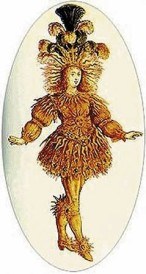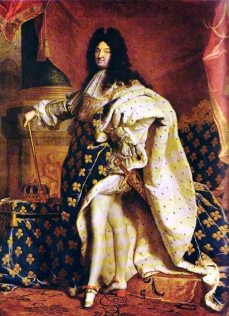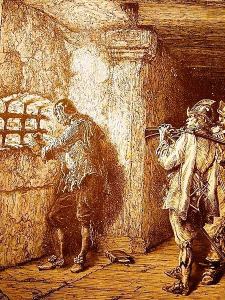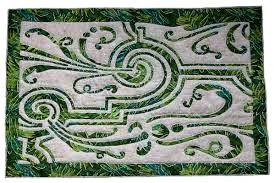Tags
Alexandre Dumas, Colbert, Jean de La Fontaine, Jean-Baptiste Lully, Louis XIV, Nicolas Fouquet, The Man with the Iron Mask, The Three Musketeers, Vaux-le-Vicomte
 Vaux-le-Vicomte: Nicolas Fouquet’s Castle
Vaux-le-Vicomte: Nicolas Fouquet’s Castle

Nicolas Fouquet, by Sébastien Bourdon (Musée national du château de Versailles) (Photo credit: Larousse)
Nicolas Fouquet
The story of the “City Rat and the Country Rat,” or “Town Mouse and Country Mouse” is not insignificant. Our country mouse is as poor as the peasants who paid the astronomical bill Louis XIV ran up building Versailles. But Louis had seen Vaux-le-Vicomte, the castle Nicolas Fouquet, the “Superintendent of Finances,” had built for himself and Louis XIV was not about to be housed in humbler dwellings than the magnificent château owned by his “surintendant des Finances,” a patron of Jean de La Fontaine, and various authors and artists.
Nicolas Fouquet,[i] marquis de Belle-Île, vicomte de Melun et Vaux (27 January 1615 – 23 March 1680) was “Superintendent of Finances” in France between 1653 and 1661. A lawyer by training, he had risen to prominence rapidly and had been named “Superintendant of Finances,” a position Italian-born Cardinal Jules Mazarin (14 July 1602 – 9 March 1661), who ruled France, could not deny him. Fouquet knew that Mazarin was using his own position as “Prime Minister” to amass wealth, while the “country mice” of France lived in abject poverty.
 Le chancelier Séguier, by Charles Le Brun (1655)
(Photo credit: Larousse)
Le chancelier Séguier, by Charles Le Brun (1655)
(Photo credit: Larousse)
Vaux-le-Vicomte
Nicolas Fouquet’s château, Vaux-le-Vicomte,[ii] had been built by the future architect of Versailles: Louis Le Vau, and was decorated by Versailles’ future painter Charles Le Brun, who owed his training as an artist to a powerful individual, le chancelier Séguier.[iii] As for the grounds, they were designed by landscape artist André Le Nôtre. Fouquet had therefore assembled the team that would later build Louis XIV’s castle at Versailles, a community where his father, King Louis XIII, a composer, had a hunting lodge he used as his main residence. Fouquet also owned Belle-Île-sur-Mer, a fortified island where he could live if ever he needed a safe haven. As well, Fouquet had bought several private properties in Paris, “hôtels” or “hôtels particuliers,” and, in 1651, a widower, Fouquet married a very wealthy Spanish woman, Marie de Castille.
A Feast
In 1661, shortly after Louis XIV ascended the throne, Fouquet hosted a fête that could not be rivalled and that convinced Louis XIV, first, that Fouquet was using public funds for private purposes and, second, that he, the King, needed a castle that would be more beautiful than the castle of a mere “subject,” at any cost.
François Vatel, maître d’Hôtel
The fête was a great success. François Vatel, Louis II de Bourbon-Condé‘s future maître d’hôtel served the finest of foods, including tropical fruit grown in Fouquet’s green house, an orangerie, located on his estate. Louis XIV would ask architect Jules-Hardouin Mansart (16 April 1646 – 11 May 1708) to build an orangerie at Versailles.
Molière and Lully
Moreover, on 17 August 1661, dramatist Molière premièred Les Fâcheux, a comedy and a ballet, at Vaux-le-Vicomte. The king loved to dance and had discovered a composer who could provide the appropriate music, Italian-born Giovanni Battista Lulli, renamed Jean-Baptiste Lully (28 November 1632 – 22 March 1687). Molière was one of Fouquet’s protégés, but he was also a friend of Louis XIV.

 Louis XIV in Lully‘s Ballet de la nuit, 1653 (Photo credit: Wikipedia)
Louis XIV, by Hyacinthe Rigaud, 1701 (Photo credit: Wikipedia)
Louis XIV in Lully‘s Ballet de la nuit, 1653 (Photo credit: Wikipedia)
Louis XIV, by Hyacinthe Rigaud, 1701 (Photo credit: Wikipedia)
Fouquet Arrested and Jailed
Louis quickly suspected embezzlement (malversation de fonds publics) on the part of Nicolas Fouquet, abolished the position of Superintendant of Finances, arranged for Fouquet to accompany him to Nantes where D’Artagnan, whose full name was Charles Ogier de Batz de Castelmore, Comte d’Artagnan (c. 1611 – 25 June 1673), one of his Musketeers (les mousquetaires de la maison militaire du roi de France), took the very wealthy Fouquet into custody. Famed and prolific novelist Alexandre Dumas, père (24 July 1802 – 5 December 1870) used D’Artagnan as the leading figure in his Trois Mousquetaires (1844).
This festive event sealed Fouquet’s fate.Whether or not justice was served, we may never know, but in December 1664, after a three-year trial, Nicolas Fouquet was found guilty of embezzlement and sentenced to banishment, a sentence commuted to life imprisonment. (See Fouquet, Wikipedia.) Fouquet died at Pignerol (now Pinerolo), in 1680. Jean-Baptiste Colbert, who coveted a place as a member of the Conseil du Roi, assembled the material that would serve to destroy Fouquet, a possible rival. Unlike Louis XIII, who let France be governed by prime ministers: Cardinal Richelieu, replaced, in 1642, by Cardinal Jules Mazarin, Louis XIV did not want a prime minister.
 The Three Musketeers , by Maurice Leloir, 1894 (Photo credit: Wikipedia)
“Athos, Porthos, Aramis & D’Artagnan”
The Three Musketeers , by Maurice Leloir, 1894 (Photo credit: Wikipedia)
“Athos, Porthos, Aramis & D’Artagnan”
 The Man with the Iron Mask, c. 1872 (Photo credit: Wikipedia)
The Man with the Iron Mask, c. 1872 (Photo credit: Wikipedia)
Interestingly, Fouquet served his sentence in the same prison as the man with the iron mask (l’homme au masque de fer), whose identity has yet to be determined, but who was Fouquet’s man-servant for a short period. Rumour has it that the man in the iron mask may have been Louis XIV’s father. Louis XIII is unlikely to have fathered a son. As noted above, he preferred to live with friends in his hunting lodge at Versailles, where Louis XIV, would have his castle built.
Fouquet as patron of the Arts: Jean de La Fontaine
Jean de La Fontaine, the author of Le Songe de Vaux, tried to help his patron and, as a result, he was not “elected” to the Académie française until 1682. In fact, under Louis XIV, a candidate was not “elected” to one of the forty seats of the Académie, les quarante immortels; one was appointed by the King himself. The Académie française was established by Cardinal Richelieu (9 September 1585 – 4 December 1642) in 1635. It perished in 1793, during the French Revolution, but was reestablished by Napoléon Bonaparte in 1803.
Vaux-le-Vicomte had been a lesson to La Fontaine who set about writing fables that he called “a comedy immense,” cultivating a discreet form of congeniality with his peers and hosts. I believe he was the rustic rather than the city rat. Between the lines of his fables, he painted a fresco of his era. However, he did so using anthropomorphism. His animals, the elements, the trees, all were humans in disguise and stereotypes, which protected the fabulist. The Lion may be king, but the King is not a lion and would not want to be. Imagine the ridicule Louis XIV would have brought unto himself, if he had allowed anyone to think that he was an animal, La Fontaine’s lion. La Fontaine therefore wrote
Une ample comédie à cent actes divers Et dont la scène est l’univers. Le Bûcheron et Mercure (V.i; V.1) Thus swells my work—a comedy immense Its acts unnumbered and diverse, Its scene the boundless universe. The Woodman and Mercury (V.i; V.1)Conclusion
Fouquet’s story is well-known. Absolutism would not allow transgressions. Not only was Fouquet jailed for the remainder of his life, but the possessions he cherished were seized. Under Louis XIV, the only person who could keep a king humble was Jacques-Bénigne Bossuet, whose sermons are famous and who emphasized that all of us are mere mortals: memento mori.
____________________[i] Nicolas Fouquet http://www.larousse.fr/encyclopedie/personnage/Nicolas_Fouquet/187131 (FR) http://en.wikipedia.org/wiki/Nicolas_Fouquet [ii] “Vaux-le-Vicomte”. Encyclopædia Britannica. Encyclopædia Britannica Online.
Encyclopædia Britannica Inc., 2013. Web. 20 Aug. 2013 <http://www.britannica.com/EBchecked/topic/624201/Vaux-le-Vicomte>. [iii] Portrait du chancelier Séguier http://www.larousse.fr/encyclopedie/oeuvre/Portrait_du_chancelier_S%C3%A9guier/181324 (FR) http://en.wikipedia.org/wiki/Pierre_S%C3%A9guier
Vaux-le-Vicomte



Micheline, you have completely taken over my last hour! Actually, I thank you. I always assumed the Man in the Iron Mask was fiction – silly me. I think this is so fascinating! Fantastic post, as always! 🙂
LikeLike
Dear tk,
The stories behind history are fascinating. These are stories I told my students. It helped them remember “history,” and it was a break. There was a Man in the Iron Mask. According to Dumas, he was Louis XIV’s twin brother. But Wikipedia suggests he was Italian, which makes sense. He was buried under an Italian name.
I thank you for your kind words.
LikeLike
Very, very interesting, thank you again. I am also very pleased that you take such lengths to teach your students! I wish I’d had a teacher that did that. 🙂
LikeLike
I loved teaching and enjoyed telling stories to my students. For instance, tobacco and sugar became very important to the French. So important that they let New France go. We were a financial burden. If the Huguenots had been allowed to stay in New France and France, most of North America would be French. But the Huguenots had to flee. They knew how to make money. The French population of New France was made to believe that the more they suffered during their lifetime, the better their chances of going to heaven. Jansenism!
Take care,
Micheline
LikeLike
That is so interesting! Thank you for that! Fantastic! 🙂
LikeLike
Thank you for your note tk,
It would be useful to teach students the “real” history of their country. Quebec nationalists believe they lost a battle, the Plains of Abraham. But New France won the final battle: Carillon. The truth is that France chose not to keep New France. The French had dilapidated their money. From Guadeloupe and Martinique they at least received sugar. However, France and England negotiated good terms for the French they were leaving behind. England promised not to take away our farms, our seigneuries, our religion and in 1774, we were made into fully-fledged Canadians who lived in a democracy. There were of course little problems, but nothing that can legitimize excess and friction, i.e. separatism. It is as though Quebec wanted to be victims: Jansenism. There is so much to say… Thank you for writing tk, I’ve not been well, but I’ll recover. Love, Micheline
LikeLike
I always enjoy your comments, Micheline!
I hope you feel better soon! 🙂
LikeLike
Thank you TK
I will have to get some rest and should be fine again.
Love,
Micheline
LikeLike
Bonjour de Toulouse, France! Encore un article super-intéressant… Vous aimez l’histoire de France, Micheline – me, too, également… 🙂 Merci pour vos “haltes” à New Playground et bonne chance dans toutes vos activités… Respectful regards, Mélanie NB
LikeLike
Bonjour Mélanie,
Oui, je m’arrête souvent chez vous. Louis XIV a conçu Versailles après avoir vu Vaux-le-Vicomte. J’espère que vous vous portez bien.
Bien cordialement,
Micheline
LikeLike
The story behind a story; always so interesting.
LikeLike
That story is fascinating Gallivanta and it is a true story. Versailles was built so Louis XIV would have as beautiful a castle as Nicolas Fouquet. After he was jailed, Fouquet was not allowed to speak to anyone, except the person who served his meals. I’m surprized he lived until 1680. His case is still under investigation, by historians and other scholars.
Dear Gallivanta, thank you for writing. Love, Micheline
LikeLike
Yes, amazing he lived until 1680. Some people seem to be very resourceful in solitude.
LikeLike
He must have had some hope of regaining, not his castle, but at least his fortified castle. He saw one person once: his wife. He and the man in the iron mask could not talk to one another privately. When they were together, there were guards. It’s a terrible story. Court intrigues!
Take care Gallivanta.
Love Micheline
LikeLike